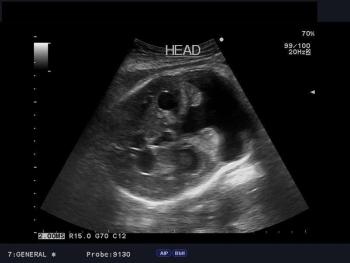
This is an early first trimester pregnancy with pelvic discomfort. What are your findings and what is a possible diagnosis?

This is an early first trimester pregnancy with pelvic discomfort. What are your findings and what is a possible diagnosis?

Removing specimens transvaginally during laparoscopic resection of adnexal masses is associated with less postoperative pain than transumbilical removal, according to a new study.

An article in the New York Times drew attention to an impending physician shortage, a phenomenon that has been predicted for years. Is your practice, or your area of the country, feeling the impact?

This is a 2nd trimester pregnancy. What are your findings and diagnosis in this case (ultrasound images are of the pelvis and uterus in particular)?

Researchers are about to launch a large, multinational Phase III clinical trial to test the safety and effectiveness of a vaginal ring containing the experimental antiretroviral (ARV) drug dapivirine. The ring is intended to provide women with another means to prevent HIV acquisition through vaginal intercourse.

Social media can help a physician market their practice, build their brand, land a new job and more. Here's how.

The answer to that question seems to be yes, and the impact may be influenced by the timing of the biopsy or curettage, according to the results of a Cochrane Collaboration review.

Are you wondering what the recent ACA Supreme Court decision means for OB/GYNs? Contemporary OB/GYN's editor-in-chief tries to figure it out.

As women transition into menopause, they may wish to have hormone therapy. Find out what the risks and benefits of the therapy are.

An OB/GYN discusses his many experiences with hysteroscopic myomectomy during 24 years of practice.

A review of a lawsuit where defendant B allegedly did not administer magnesium sulfate in a timely manner, causing premature delivery of an infant.

Wondering whether or not you should screen your patients for thyroid disease?

For many women, the 50s are a milestone decade. In addition to other changes, menopause can bring about sexual dysfunction.

Data are limited and evidence inconclusive on whether exercise prevents glucose intolerance in pregnant women.

In this protocol, Dr. Lockwood reviews the pathophysiology, diagnosis, and treatment of autoimmune disease in pregnancy. Included are guidelines for management of systemic lupus erythematous (SLE), rheumatoid arthritis (RA), scleroderma, and rarer autoimmune disorders.

With 20% of U.S. MDs older than age 65, there is increasing concern about how to monitor and manage the potential for cognitive decline in physicians. Is an annual fitness-for-duty exam for older doctors a good idea?

This is an early 3rd trimester pregnancy. What is your diagnosis of this placenta?

In a new systematic review, researchers studied the benefits and harms of pharmacological therapies for overactive bladder in women.

For the first time, we have a drug in our arsenal to help prevent the spread of HIV infection to uninfected individuals.

Cancer passed in utero, trading art for health care, urinary incontinence in young women and more in the ob/gyn week in review.

This is a common uterine condition. What's your diagnosis?

Cranberry-containing products may be more than just a folk remedy for urinary tract infections (UTIs). A systematic review and meta-analysis published in the Archives of Internal Medicine concludes that cranberry-containing products offer women protection against UTIs, particularly those prone to recurrent infections.

In a systematic review of UAE versus other surgical interventions for symptomatic uterine fibroids, researchers concluded that UAE offers substantial improvements in symptoms of uterine fibroids but may not help women who want to retain their reproductive potential.

From nutritional supplements to pregnancy support products to spa services, more ObGyn practices--and physicians' offices in general--are turning to ancillary products as additional sources of revenue.

This is a middle aged woman with pelvic discomfort and normal menses. Sagittal images of the uterus are shown. What is your diagnosis?

Use of selective serotonin reuptake inhibitors (SSRIs) during pregnancy is associated with smaller fetal head circumference-a prenatal marker of brain volume-and with higher risk of preterm birth (< 37 weeks), according to findings from a prospective population-based study from the Netherlands.

Pregnant women who are unable or unwilling to quit smoking can help improve lung function in their newborns by taking vitamin C daily.

A new study found that placement of a midurethral sling can halve the rate of incontinence after prolapse surgery

Identify the anomaly in this 35 week fetus as seen in these axial and sagittal images of fetal head.

Babies born to moms who were in hurricanes during pregnancy have higher rates of health problems at birth, according to a working paper issued by the National Bureau of Economic Research.